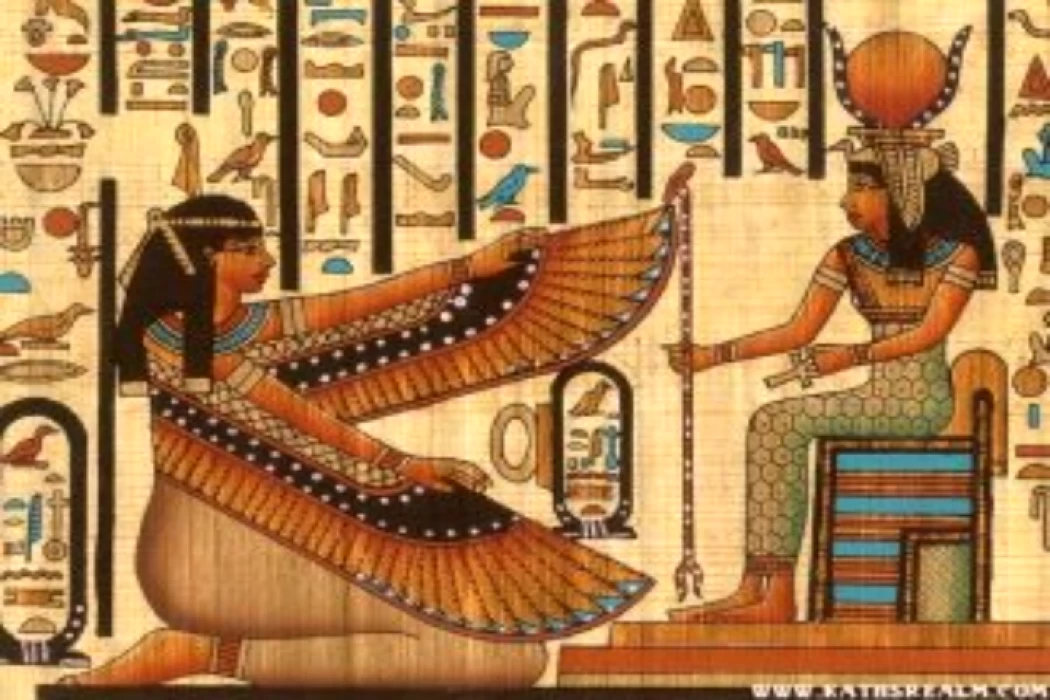
Diosa Nekhbet | Diosa egipcia
Nekhbet se representaba a menudo desplegando sus alas sobre el gobernante mientras agarraba con su garra la imagen del cartucho o diferentes emblemas. El centro del culto a Nekhbet era El-Kāb, pero su principal epíteto la convertía en la inmortal de Hierakonpolis (o Nekhen), la ciudad tradicional situada frente a El-Kāb, en la región geográfica del río Nilo.
Nekhbet era la patrona de la división administrativa, mostrando la unidad de las "Dos damas" dentro del nombre Nebty del gobernante (con su homólogo Wadjet). Se la conocía normalmente como "Hedjet" (Corona Blanca) en relación con la corona de la división administrativa y con frecuencia aparece como un dispositivo heráldico que representa la división administrativa. También era la defensora de los niños de la realeza y, en épocas posteriores, de todos los niños pequeños y las mujeres embarazadas.
Hay pruebas de que Nekhbet ya era estándar en el Egipto predinástico, pero estaba relacionada específicamente con la ciudad de Nekheb (su nombre significa realmente "la de Nekheb"). Sin embargo, para la primera cantidad de familias, Nekheb y Nekhen (centro de culto de la deidad egipcia el Viejo) se habían incorporado y ella o él y Wadjet se combinaron para hacer el nombre Nebty del faraón; su posición como representante de la división administrativa estaba absolutamente establecida.
Las referencias en los Textos de las Pirámides (de la Quinta Dinastía) aseguran que Nekhbet era considerada una creadora inmortal con el epíteto de "Padre de Padres, Madre de Madres, que ha existido desde el principio, y es Creadora de este Mundo". Ella fue diagramada en la ropa del rey Nemes como un buitre o una serpiente y de la ropa de buitre del cuarto pueblo para una excelente esposa real.
Descubra más acerca de los dioses y diosas del antiguo Egipto a través de Luxor excursiones de un día también si se puede abordar el tren durante un par de horas al norte también se puede cubrir durante Asuán excursiones de un día o incluso nuestra gira de 2 días a Luxor desde Asuán hay una gran cantidad de Egipto excursiones de un día que van a Luxor de las diversas ciudades egipcias como Hurgada excursiones de un día por tierra a Luxor o si usted viene para unas vacaciones de ocio en Sharm se puede tomar el avión por un día durante Sharm El Sheikh excursiones para explorar toda la ciudad histórica.
Reserve ahora para una gran experiencia de Vacaciones en Egipto y paquetes de vacaciones en Egipto Luxor tours de un día, Asuán tours de un día, y los tours de lujo de Egipto para disfrutar de la fabulosa pirámides de Giza tour y la Esfinge, el Museo Egipcio tour, Valle de los Reyes, coptos y El Cairo islámico, así como el templo de Abu Simbel, la mejor manera de explorar el país son los tours de un día de Egipto, El Cairo tours de un día y tours de un día de El Cairo desde el aeropuerto para ver todas las maravillas increíbles del antiguo Egipto y aprender más sobre la historia de Egipto
References within the Pyramid Texts (from the Fifth Dynasty) ensure that Nekhbet was thought-about to be a creator immortal with the epithet “Father of Fathers, Mother of Mothers, who has existed from the start, and is Creator of this World”. She was diagrammatical on the king’s Nemes clothing as a vulture or a snake and from the Fourth folk vulture clothing for an excellent royal spouse.
In ancient mythology, Nakhbet is considered a local goddess from the early pre-dynastic era. The goddess was called the patroness of the city of Nakhbet (Kaab), and she later became the patroness of Upper Egypt and was the second patroness of all of ancient Egypt when it was unified. In Egyptian religion, Nakhbet was seen by the people as the protector of all the rulers of Upper Egypt. Like a bird eagle the powerful goddess.
In ancient mythology, Nakhbet is considered a local goddess from the early pre-dynastic era. The goddess was called the patroness of the city of Nakhbet (Kaab), and she later became the patroness of Upper Egypt and was the second patroness of all of ancient Egypt when it was unified. In Egyptian religion, Nakhbet was seen by the people as the protector of all the rulers of Upper Egypt. Like a bird eagle the powerful goddess.
Nekhbet was often pictured as spreading her wings over the ruler while grasping in her claw the cartouch image or different emblems. She appeared as a girl, typically with a vulture’s head, sporting a white crown, and was generally delineated suckling the ruler. the middle of Nekhbet’s cult was El-Kāb, however, her principal epithet created her the immortal of Hierakonpolis (or Nekhen), the traditional city opposite El-Kāb, on the geographical region of the Nile River.
Nekhbet has been depicted since the beginning of the historical era in the form of a female vulture, which is still occasionally seen in Upper Egypt. She is usually depicted in profile or with wings spread in a straight pose, with only the head and feet depicted in profile. She is usually depicted holding the Sn sign in her talons, which signifies eternity or dominance. Nekhbet is identified with the goddess Wadjet, her counterpart in Lower Egypt, and thus Nekhbet is sometimes depicted as her serpent counterpart.
With Wadjet, she embodied one of the five royal titles, Nebty, meaning "the two ladies" or "belonging to the two ladies." Nekhbet also personified the crown of Upper Egypt. In human form, she may sometimes be depicted as a woman wearing a vulture-shaped headdress or crown, or she may wear the White Crown of Upper Egypt.
Nekhbet was the patron of administrative division, showing the unity of the “Two ladies” within the Nebty name of the ruler (with her counterpart Wadjet). She was typically known as “Hedjet” (White Crown) in relevance to the crown of the administrative division and frequently seems as a heraldic device representing the administrative division. She was conjointly a defender of royal kids and, in later periods, of all young kids and expectant mothers.
There is proof that Nekhbet was already standard in Predynastic Egypt however was specifically related to the city of Nekheb (her name truly means “she of Nekheb”). However, by the first family amount, Nekheb and Nekhen (cult center of Egyptian deity the Elder) had incorporated and she or he and Wadjet were combined to make the Nebty name of the pharaoh; her position as a representative of administrative division was absolutely established.
There was a huge cult cabin for Nakhbet at El Kab, although little remains of it. Since at least the Old Kingdom, Nakhbet has been characterized by the white crown of Upper Egypt, and was thus closely associated with the monarchy and the person of the king, so she was mythologically known as the "mother of the king." The pyramid texts depicted her as a mother goddess in the form of a large white cow. The pyramid texts depicted her as a matriarch in the form of a large white cow. In royal birth scenes, such as those found in the funerary temple of King Sahuros at Abu Sir, Nakhbet is represented as a nurturer or protective caretaker of the king.
There is proof that Nekhbet was already standard in Predynastic Egypt however was specifically related to the city of Nekheb (her name truly means “she of Nekheb”). However, by the first family amount, Nekheb and Nekhen (cult center of Egyptian deity the Elder) had incorporated and she or he and Wadjet were combined to make the Nebty name of the pharaoh; her position as a representative of administrative division was absolutely established.
Along with Wadjet, she embodied one of the five royal titles, Nebty, meaning "the two ladies" or "belonging to the two ladies." Nekhbet also personified the crown of Upper Egypt. In human form, she was sometimes depicted as a woman wearing a vulture-shaped headdress or crown, or she might wear the White Crown of Upper Egypt.
















